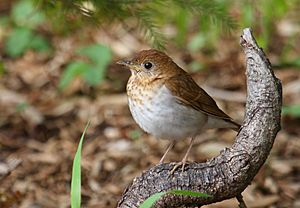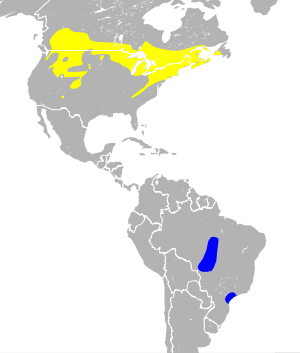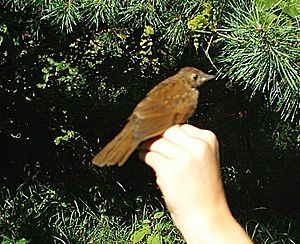Veery facts for kids
Quick facts for kids Veery |
|
|---|---|
 |
|
| Conservation status | |
| Scientific classification | |
| Genus: |
Catharus
|
| Species: |
fuscescens
|
 |
|
| Veery range
Breeding range Wintering range |
|
| Synonyms | |
|
Hylocichla fuscescens |
|
The veery (Catharus fuscescens) is a small North American bird that belongs to the thrush family. It's part of a group of similar birds in the Catharus genus, which also includes the gray-cheeked thrush, Bicknell's thrush, Swainson's thrush, and Hermit thrush. People sometimes call the veery "Wilson's thrush" (named after Alexander Wilson) or "tawny thrush." There are a few types of veeries, like the eastern Veery, the western Veery (also called the Willow Thrush), and the Newfoundland Veery.
The name fuscescens comes from a Latin word meaning "dark" or "blackish." The English name "veery" might sound like the bird's call.
Contents
What Does a Veery Look Like?

Veeries are about 16 to 19.5 centimeters (6 to 7.5 inches) long. They usually weigh between 26 and 39 grams (about 1 ounce), but some can be heavier. Their wingspan is around 28.5 centimeters (11 inches).
Adult veeries are mostly light brown on their backs and have white undersides. Their chest is a light reddish-brown with faint brownish spots. They have pink legs and a light ring around their eyes. Veeries in the eastern parts of their home range look more reddish-brown on top, while western veeries are more olive-brown. It's easier to tell eastern veeries apart from other thrushes because of their color.
Veery Sounds and Calls
This bird has a beautiful, flute-like song that spirals downwards. It often sings from a hidden spot low in the trees. Its most common call is a harsh, descending sound that sounds like "vee-er," which is how it got its name! Other sounds they make include a soft chuckle, a sharp "wuck," and a slow "wee-u." Studies show that veeries sing less when they hear sounds of Barred owls, probably to avoid being noticed by predators.
Where Do Veeries Live?
Breeding and Wintering Homes
Veeries build their nests in wet deciduous forests across southern Canada and the northern United States. They like places with thick plants and undergrowth, especially near water sources like streams.
These birds are migratory, meaning they travel long distances. They fly all the way to eastern South America for the winter. Their winter homes can be found in places like the Amazon basin, parts of Venezuela, and Brazil. During their journey, they stop in places like the Gulf of Mexico coast, the Carolinas, Cuba, Jamaica, Colombia, and Venezuela. Very rarely, they might even fly to western Europe.
What Do Veeries Eat?
Veeries look for food on the forest floor. They flip over leaves to find insects hiding underneath. They might also fly up to catch insects in the air. Their main diet includes insects and berries. During the time they are raising their young, insects are very important. In late summer and fall, they eat mostly fruits and berries.
Nesting and Young
Veeries build their nests on the ground or close to the bottom of a bush. Their nests are shaped like a cup and have three layers. The outside layer is made of leaves and small branches. The middle layer is woven material, and the inside is lined with soft things like bark, roots, and seeds. They use parts from many different plants, even some that are not native to the area.
A nest usually holds three to five greenish-blue eggs, which might have brown spots. The female bird sits on the eggs for 10 to 14 days to keep them warm. Both parents help feed the baby birds. Young veeries are ready to leave the nest when they are about 10 to 12 days old.
Sometimes, a related bird called the wood thrush has taken over some of the veery's living areas. However, there was one time when a wood thrush actually helped take care of baby veeries, feeding them even more than their own parents did! Veeries are sometimes hosts for the eggs of brown-headed cowbirds, which means the cowbirds lay their eggs in the veery's nest for the veery to raise. Male veeries sometimes help feed young at more than one nest, and sometimes more than one male will help feed the same nest.
What Threats Do Veeries Face?
Veeries face several challenges. One threat is Brown-headed Cowbirds laying their eggs in veery nests, which can make it harder for veery chicks to survive. Climate change and changes to the forests in the Amazon are also big concerns.
It seems that the number of veeries is going down. Studies show that veery populations have decreased in most of their range from 1966 to 2013. Some people worry that using parts of non-native plants in their nests might be bad for them, but this hasn't been proven yet. Other possible threats include losing their forest homes, and predators like squirrels, chipmunks, and raptors (birds of prey).
See also
 In Spanish: Zorzalito rojizo para niños
In Spanish: Zorzalito rojizo para niños


